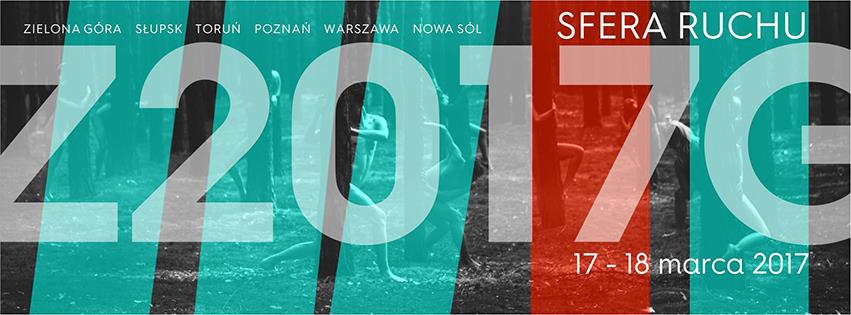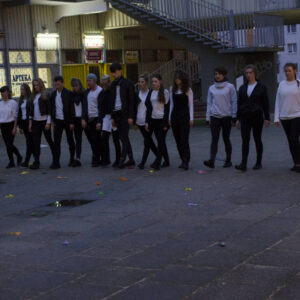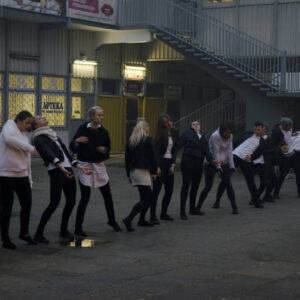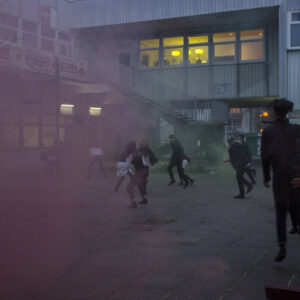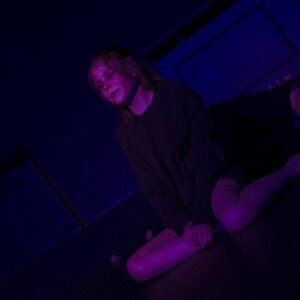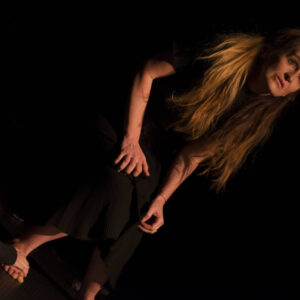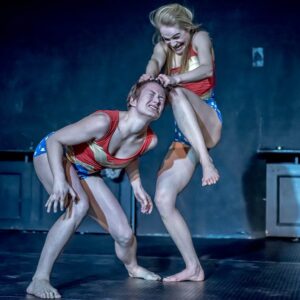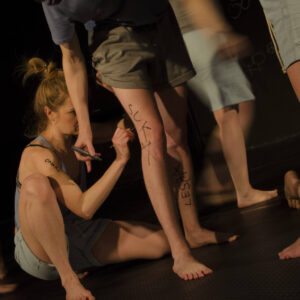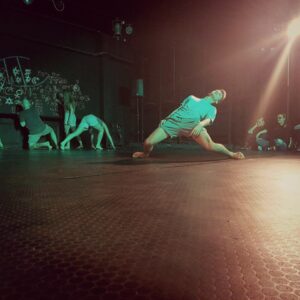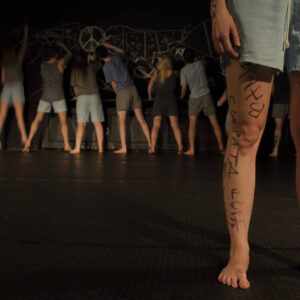In the Sphere of Motion and the galaxy of movements
Sfera Ruchu Festival - 2017-03-17 - 2017-03-19
Last weekend, the Department of Culture Animation and Andragogy of the University of Zielona Góra was filled to the brim with enthusiasts of dance theater, physical theater and contemporary dance. Crowds of viewers surrounding the building, looking for an alternative to the literalness of traditional theater, are already the trademark of the Sfera Ruchu festival, which has been organized for seven years by the Dance Theater Studio in Zielona Góra, created by Dr. Marek Zadłużny.
During the two-day festival, operating under the auspices of the Youth Center for Culture and Education "Dom Harcerza", viewers had the opportunity to watch four performances by the hosts and six presentations by guests, including: Teatr Ruchu Enza, Terminus A Quo, Wolna Forma, Iwona Wojnicka, Gosia Mielech and Projekt PańFu.
Everyday games - they versus us
Sphere of Movement was opened by an outdoor performance prepared by Pracownia Teatr Teatr Tańca in cooperation with Marta Pohrebny (selection and reading of texts) and Bartosz Wilk (music). "Fun" (performed by: Marek Zadłużny, Justyna Śmietańska, Agnieszka Jodłowska, Marta Pelińska, Magda Bębenek, Katarzyna Pawlak, Kalina Grupa, Kinga Górska, Natalia Zaleszczak, Karolina Pachurka, Dorota Margalska, Martyna Blachowska, Agata Kierońska, Radosław Bajon and Zaborniak) is a multi-layered, very topical story about reducing society to the level of an impersonal mass that does not count and has no value, and therefore "real", better people, i.e. powerful wealthy and politicians in power, can knead it like dough by trying on various forms, sprinkling slogans with colored icing and throwing each other to devour.They grew up among propaganda and advertising slogans, from childhood they got used to fighting (first for dominance in the backyard gang, good grades and a place in the school football team, then for a better position, bigger house, more expensive car) and they got used to the images of war, suffering, and even death - which in the performance reflects the dancers playing in the classroom to the rhythm of the counting-out: "a bomb fell into the basement, she wrote on the board: SOS ..." - we let them go to the front every day. We stand on both sides of an artificially erected barricade to fight, which there are no winners, bombarding each other with hate speech and ideology (symbolized in the performance by torn newspapers, colorful but empty balloons thrown like grenades and artfully used pyrotechnic materials - including colored smoke candles) borrowed from the headlines of articles,political comments on Twitter or parliamentary speeches. Later, we pray to God for grace and prosperity.
I wonder - what would his reaction be if we could see it? Let me guess it by quoting a fragment of Grażyna Moroz's poem "panta rhei", which seems to me to be an exceptionally adequate summary of the story presented in "Zabawa": "images / children with a wafer of faith / children in their arms with rifles / children in a garbage can flow to heavenly God. / communion of love komuna hate / [...] so He no longer wants to be like a man / and introduces errata to Genesis ".
The show "Fun" arranged in the space of a block of flats and based on sequences performed with true technical mastery, moving from carefree fun to intertwining scenes of collective lethargy, brutal fight and prayer, shocking with the power of communication! It becomes a "protest dance" almost as strong as the famous the poem "To a simple man", in which Tuwim warned against the scream of letters from the front pages of journals, which was always backed by "belly men".
Stone mystery
The second performance that Pracownia decided to add splendor to the first day of the festival was the moving premiere "Santa Muerte" based on the choreography of Marek Zadłużny and Radosław Bajon. The performance refers to the cult of the Holy Death, popular in Argentina and Spain, whose image is based on the figure of the great mother of Coatlicue (Aztec goddess of death). and rebirth), and is an attempt to depict the complex relationship between a mother and daughter (played by the dancers: Anna Pelińska and Maria Wodzak - privately also mother and daughter). It is a poetic, universal story about a strong emotional bond and the need for control opposed to the desire for freedom, space and independence.The spectrum of experiences accompanying the protagonists is manifested in it by movement (suitably subtle, harmonious,drawing from traditional ballet solutions in moments of mutual closeness or mental understanding, and violent, chaotic, emanating rage - in the moments of the daughter's rebellion), a word (spoken in Spanish that emphasizes the personal character of their conversations, which until recently were used by dancers as immigrants) day), as well as an interestingly used, multiplied prop - a stone. The gray fragments of rocks in "Santa Muerte" symbolize the protection that the mother wishes to surround her daughter with. It is with their help that she sets the right path for her, and then builds a safe asylum, which, however, turns out to be stuffy and limiting for her daughter, eventually becoming her axis conflict with the mother.a word (spoken in Spanish that emphasizes the personal character of their conversations, which until recently was used by dancers as immigrants on a daily basis), as well as an interestingly used, multiplied prop - a stone. The gray fragments of rocks in "Santa Muerte" symbolize the protection that the mother wishes to surround her daughter with. It is with their help that she sets the right path for her, and then builds a safe asylum, which, however, turns out to be stuffy and limiting for her daughter, eventually becoming her axis conflict with the mother.a word (spoken in the Spanish language that emphasizes the personal character of their conversations, which until recently was used by dancers on a daily basis), as well as an interestingly used, multiplied prop - a stone. The gray fragments of rocks in "Santa Muerte" symbolize the protection that the mother wishes to surround her daughter with. It is with their help that she sets the right path for her, and then builds a safe asylum, which, however, turns out to be stuffy and limiting for her daughter, eventually becoming her axis conflict with the mother.It is with their help that she sets an appropriate life path for her, and then builds a safe asylum, which, however, turns out to be stuffy and limiting for her daughter, eventually becoming the axis of her conflict with her mother.It is with their help that she sets a suitable life path for her, and then builds a safe asylum, which, however, turns out to be stuffy and limiting for her daughter, eventually becoming the axis of her conflict with her mother.
But one day something in the protagonists' lives changes irretrievably, the stone circle suddenly closes, the mythical snake sinks its teeth into its own tail, and rock fragments form the facade of the tomb ...
Women have wrinkles and Superwomen have super wrinkles
On the second day of Sphere Ruchu, the hearts of the audience were irretrievably stolen by long-time members of the Pracownia - Justyna Śmietańska and Marta Pelińska, who presented a thrilling performance entitled "Sis", developed and directed by the first of them. The performance opens with a sequence of synchronized dance figures performed by the dancers in complete silence. Tossed by anxiety, deprived of support, young women repeatedly fall under the weight of reality, which has unexpectedly grown into real life. in the end, however, they find the strength to stand up and tell their stories. With irony based on the mocking exploitation of recently popular affirmation techniques, the protagonists describe their fight against cancer and their daily efforts to meet the contemporary society's image of an ideal woman - beautiful, sexy ,an athletic, by all means wonderful mother and housewife, in a word - Superwoman, who effortlessly achieves professional success, and in her free time pursues numerous passions. The women therefore emphasize that they are happy to wash the pile of dishes, because this activity confirms them in the belief that their families have eaten a nutritious dinner. They admit that they feel joy to see their children dirty from head to toe because it means that they spent the day outdoors. The wrinkles on Sis's faces are not unsightly signs of aging, but "war scars" of experiences that filled them with strength. Anyway - as befits a real sis (sis, buddies, friends) - women loyally share knowledge about their smoothing, and also: slimming, firming, moisturizing,relaxation and detox (yoga exercises parodied by Śmietańska and Pelińska, combined with funny chanting of visual phrases such as: "I am beautiful, I am wise, I am calm" or "I am a temple of love" and "the goddess of light", caused an uncontrolled attack of laughter in the audience At the same time, like the American sis bound by the symbolic blood union, friends sometimes go through crises when they throw off their sweet wives' dresses from Stepford, revealing the hard side of their nature.At the same time, like the American sis bound by the symbolic blood union, friends sometimes go through crises. Then they throw off the sweet dresses of their Stepford wives, revealing the hard side of their nature. They compete and fight until they drop, only to form a new alliance shortly thereafter.At the same time, like the American sis bound by the symbolic blood union, friends sometimes go through crises. Then they throw off the sweet dresses of their Stepford wives, revealing the hard side of their nature. They compete and fight until they drop, only to form a new alliance shortly thereafter.
The day before their performance on the stage of Sfera Ruchu, Śmietańska and Pelińska presented their performance at the POKOT amateur theater festival, which was held simultaneously. They heard then that their performance was intended to ridicule modern women and their lifestyle. The objection raised in me by this otherwise masculine interpretation makes me protest. The spectacle clearly mocks not women, but the absurd patterns and abstract frames into which they are forced into each day. Dealing with this pressure is only proof that they are true Superwomen.
A few little pricks
In the late 1950s, the American psychologist Leon Festinger created the theory of cognitive dissonance. The observations made by him (continued and developed later by subsequent researchers) proved that each of us has a strong need for compliance in thoughts, judgments and attitudes. So when there is a contradiction on this line - at least two elements - we automatically begin to feel the tension that we try to reduce by reformulating the meaning of the words uttered or describing the attitude we adopt with the help of euphemisms. The revolutionary explanatory theory of behavior (often very difficult to understand) inspired the project "9.81" - the last of the performances of the Dance Theater Studio presented during the Sphere of Motion, which in Festinger's findings searches for an answer to the question about the sources of strong internal divisions,currently taking place in Poland that is culturally homogeneous.
The story (presented by: Agnieszka Jodłowska, Justyna Śmietańska, Katarzyna Pawlak, Marta Pelińska, Kalina Grupa, Kinga Górska, Natalia Zaleszczak, Dorota Margalska, Łukasz Szpilski, Marek Zadłużny, Radosław Bajon and Gabriel Zaborniak) begins with the moment of birth. the exit of the dancers from the fetal position. We are all the same then. We are moving in one direction and we think alike. However, we already feel the power of top-down forces acting on us (such as gravity pulling everyone with the same power - 9.81 m / s2), in the face of which we are passive, which the dancers emphasize with a long sequence of synchronized jumps. Habituation and dependence on their actions, combined with the need for a community of thoughts and behaviors, soon result in joining groups led by leaders.From that moment on, the community becomes a fiction, and subsequent divisions multiply like a virus according to ever new, freely determined rules.
The performance gains an interdisciplinary dimension here. An additional plan opens in it - a wall on which dancers draw DNA (with a base identical for every human being), and then blur it with a whole bunch of symbols related to various movements, religions, cults or fields of science. The genetic code thus loses to the cultural code. However, manifesting your beliefs on the walls quickly turns out to be insufficient. In order to strengthen themselves in a virtual sense of unity and strength, the characters begin to stigmatize all those who, in their opinion, "do not fit in the row", which is shown by transferring the hate speech from the wall directly to the skin of the rejected, on which the actors write nicknames and insults.
The performance is a direct commentary on a very disturbing contemporary phenomenon of collective (and most often taking place in the Internet space) campaigns against various people - from artists, celebrities or bloggers, to completely accidental victims - which we used to call "hate". derived from the English language, it perfectly reflects the action described by Festinger, as it seems to obscure the fact that "hate" is simply a wave of hatred directed at a given person and can easily lead to depression or even push them to suicide. It's just a few words, a few signs, a few posts under the photo, "a few little stings" - similar to Frida Kahlo's painting with this significant title.
All four performances presented by the Dance Theater Studio were united by an incredible impact, drawing on the achievements of various fields of art, current and controversial topics, as well as - most importantly - skilfully constructed metaphors that opened up a galaxy of meanings and emotions to the audience.
Soon we invite you to the second report from the exceptionally besieged festival Sfera Ruchu 2017!
Agnieszka Moroz
Theater Journal
March 24, 2017
